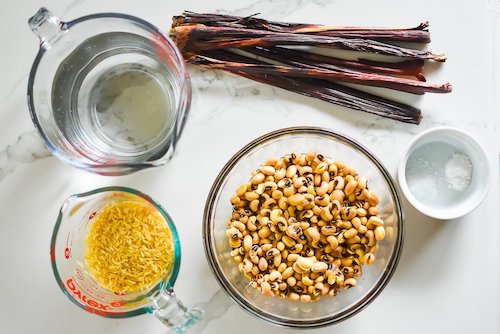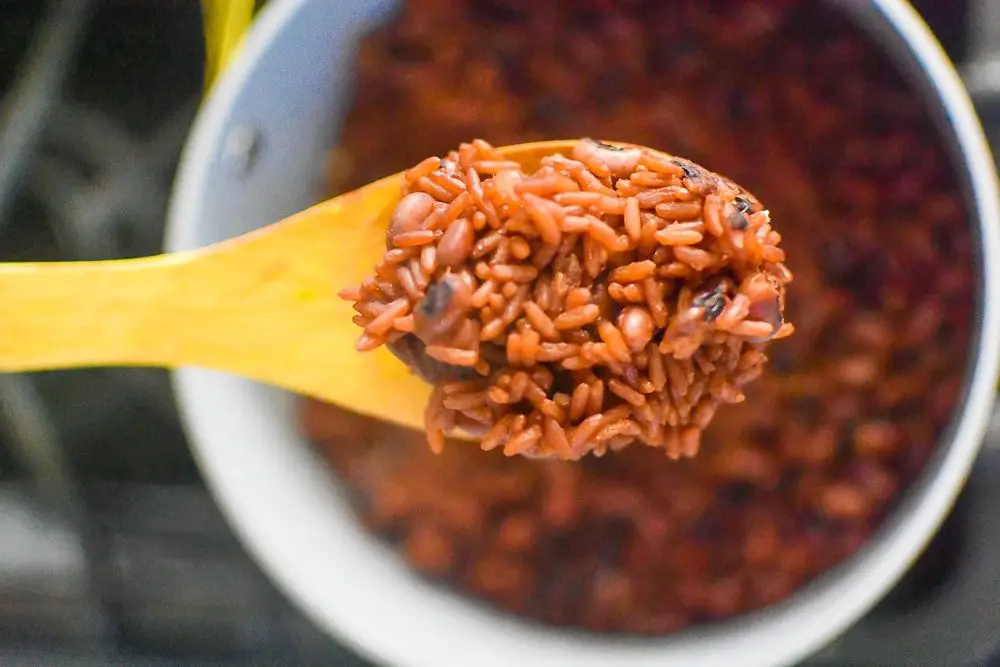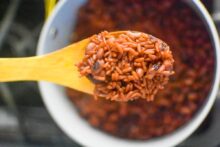Interested in Waakye? Great!
Because in this post you discover the secrets behind the Ghanaian national dish, waakye.
You'll learn about its ingredients, cooking process, serving suggestions, and health benefits. Let's get started
The Rich and Flavourful History of Waakye
It’s hard to talk about Ghanaian cuisine without mentioning waakye. It’s a dish that has been enjoyed by Ghanaians for generations and continues to be a beloved staple in the country.
Waakye is a delicious combination of rice and beans that's typically served with an array of flavour-packed sides.
The origin of waakye can be traced back to the northern regions of Ghana, where it was first prepared by the Hausa community.
It was a dish that was created out of necessity, as the ingredients used to make it were cheap and easily accessible.
Over time, waakye has become a cultural symbol in Ghanaian cuisine. What makes waakye so unique is its preparation process.
The rice and beans are cooked together with sorghum leaves or millet stalks, which give it a distinct flavour and colour. This is why you’ll often see waakye with a slightly reddish-brown hue.
The dish is then seasoned with ginger, garlic, onion, chili pepper, or other spices to add even more flavor. Waakye is not only a delicious meal but also an important part of Ghanaian culture.
It’s often eaten during special occasions like weddings, funerals, and religious holidays. It’s also an affordable meal that can be found at street vendors across the country.
As Ghana continues to modernize and globalize its food culture, waakye remains an essential part of its culinary identity. Whether you’re enjoying it on the streets of Accra or in your own kitchen at home, there’s no denying the rich history and significance behind this beloved dish known as waakye.
Waakye Ingredients

1. Rice & Beans
Waakye main ingredients are rice and beans. This combination of grains and legumes creates a complete protein, making it not only delicious but also nutritious.
Additionally, waakye gets its distinct colour from these two ingredients being cooked together. Aside from rice and beans, there are other ingredients that add flavor and texture to waakye.
2. Sorghum Leaves
Sorghum leaves are one of the core ingredients in waakye preparation. They grow in abundance throughout Ghana and many Ghanaians believe that they're essential for creating the authentic flavor that defines this dish.
Sorghum leaves have several benefits when consumed as part of the waakye meal. They contain vitamins such as A, B6, C and K which help boost immunity levels in our bodies while protecting them against diseases like cancer as well as maintaining healthy bones alongside minerals like iron which greatly help in preventing anemia (iron deficiency).
3. Millet Stalks
In some parts of Ghana, millet stalks are used instead of sorghum leaves when preparing waakye. These thin stalks lend their own unique flavor profile to the dish - slightly sweeter than sorghum - but still imparting an earthy quality that is characteristic of this hearty meal. Millet stalks are also said to have medicinal properties.
They contain antioxidants, which help prevent damage to cells in the body and reduce the risk of chronic diseases. Additionally, millet stalks are high in fiber, which can help regulate digestion and lower cholesterol levels.
4. Spices
Spices play an important role in waakye preparation. There is no one set of spices that are used universally - it can vary by region or even by cook - but some common ingredients include ginger, garlic, onion, and chili pepper. Ginger adds a slightly sweet taste to the dish while also being known for its anti-inflammatory properties.
Garlic has a savory flavor that complements the earthiness of sorghum leaves or millet stalks. Onion adds sweetness and depth to the dish while chili pepper brings a spicy kick that contrasts well with other flavors.
Overall, waakye is a dish made up of simple yet flavorful ingredients that come together into something incredibly delicious. Whether you prefer your waakye with sorghum leaves or millet stalks or a certain combination of spices, there's no denying its place as one of Ghana's most beloved dishes.
The Cooking Process
Here's are the simple steps in making Waakye:
1. Soaking Rice and Beans Overnight Before Cooking
One of the secrets to making perfect waakye is to soak the rice and beans overnight. This process not only helps to soften them but also allows them to absorb more water, which helps them cook evenly. After soaking, rinse the rice and beans thoroughly with cold water in a colander to remove any dirt or debris.
2. Boiling Rice and Beans Together with Sorghum Leaves or Millet Stalks
Once you have soaked your rice and beans, it's time to start cooking. The traditional waakye recipe involves boiling the rice and beans together in a pot with sorghum leaves or millet stalks. These ingredients give the waakye its distinctive color and flavor.
If you’re unable to find sorghum leaves or millet stalks, you can use tea bags instead. The acidity of tea enhances the flavour of the rice mixture, giving it that distinct taste.
During cooking, it’s important not to let all of the water evaporate before your waakye is fully cooked. Be sure to keep an eye on your pot at all times!
3. Adding Spices Like Ginger, Garlic, Onion And Chili Pepper for Added Taste
Spices are a crucial part of any good dish – including waakye! Ginger, garlic, onion and chili pepper are popular spices used in making waakye. They add flavour and depth to this already delicious dish.
The addition of ginger gives it that extra punch while garlic adds incredible aroma during cooking that will leave your home smelling amazing! Onions add sweetness without being overly pungent while chili peppers give a kick that some may find too spicy but if you love spice then go ahead use as much as you like!
Incorporating these spices requires patience and experimentation. You’ll need to use your personal taste preferences when determining how much of each spice to add.
Some people prefer more ginger, while others may want to kick up the heat with extra chili pepper. Whatever your preference, it's important to season the waakye well so that it’s packed with flavour.
That's it for cooking process! In the next section, we will take a look at the different serving suggestions for waakye.
Serving Suggestions
Here are some delicious food you can pair with Waakye to enhance it's experience :
1. Plantains and Shito: A match made in heaven
Fried plantains, also known as kelewele, are a popular side dish that pairs well with waakye. The sweet and spicy flavor of the plantains compliments the savory taste of waakye.
You can find kelewele at street vendors or make it yourself by seasoning sliced plantain with ginger, garlic, onion, chili powder or fresh pepper. Shito is also a common accompaniment to waakye.
It's a Ghanaian hot sauce made from fish or shrimp that's been spiced and fried with oil until charred bits form. It's great for adding some heat to your meal.
2. Spaghetti: Ghanaian Fusion
Waakye and spaghetti may seem like an unlikely duo, but it’s surprisingly delicious. Spaghetti is served with the stewed beans and rice mixture to add starchiness to the meal. You can mix it into the waakye or eat them separately.
3. Eggs: A Protein Powerhouse addition
Boiled eggs are often paired with waakye for added protein. Some people also fry eggs and serve them on top of their waakye for a more filling meal.
4. Avocado Salad: A Fresh Side Dish Option
If you’re looking for something lighter to pair with your waakye you can try adding some avocado salad on the side. Fresh greens such as lettuce and tomatoes plus diced avocado create a refreshing taste that goes well alongside the hearty flavors of the rice-and-bean combination.
5. Soup or Gravy: Another Way To Enjoy Waakyie
While many Ghanaians tend to use soup or gravy as an accompaniment for their starchy meals like fufu or banku, it’s also a great addition to waakye. The gravy can be made in many different ways depending on the cook's preferences but usually contains meat stock, tomatoes, and other ingredients like carrots and onions.
Some people opt for light soup or groundnut soup with their waakye, while others prefer tomato-based stews. Gravy can add more moisture to the meal and give it a slightly different taste than eating waakye alone.
Regional Variations of Waakyie
Here are some of the little variation of waakyie from region to region
1. Color and Flavour Differences in Waakye
Waakye is more than just rice and beans boiled together. Each region of Ghana has its own unique blend of ingredients, spices, and cooking techniques that create subtle differences in the color, taste, and texture of waakye.
For example, in the Northern Region of Ghana, they use red sorghum leaves instead of millet stalks to give it a reddish-brown color. This gives a slightly earthy flavor to the dish that pairs well with spicy stews or soups.
2. The Southern Region's Take on Waakye
In the southern region of Ghana, waakye is traditionally served with a flavorful tomato-based stew known as shito. Shito is made from peppers, onions, ginger, garlic and other spices cooked down with dried fish or shrimp into a thick paste that has been referred to as "Ghanaian hot sauce" by some. The shito's rich umami flavor complements the nutty taste from the brown beans used in this variation.
3. Eastern Region's Blend of Spices
In the Eastern Region of Ghana where spicy food reigns supreme, waakye takes on an entirely different character altogether. Popularly known there as "Red Red," this type uses red palm oil instead of vegetable oil for frying plantains which are then served along with stewed black-eyed peas mixed with plenty of ginger & garlic paste plus bits of smoked fish or meat. This gives it a richer flavor profile that can be quite overwhelming for those not accustomed to spicy foods.
4. Western Region's Sweet Twist on Waakye
The western region also has its unique variation called "Nkatie Burger" which literally means peanut burger due to the groundnut sauce used during preparation. This version of waakye is sweeter and nuttier than the other variations because of the groundnut sauce.
It is also accompanied by yam fries, Jollof Rice or fried plantains which lend a unique sweetness to this dish. The peanut sauce gives it an extra depth of flavor that's unlike any other waakye you'll ever taste!
Waakye Recipe

Here's the step by step instruction on how to make Waakye
INGREDIENTS:
- 2 cups of rice
- 1 cup of dried black-eyed peas, cow peas or red beans, soaked overnight
- 6-10 Waakye leaves (Dried millet stalk leaves or Sorghum Leaves)
- Salt to taste
- Water for cooking
INSTRUCTIONS:
- Pick out any stones or debris from the black-eyed peas and wash them thoroughly.
- Rinse the Waakye leaves and add them to a pot of water, then bring to a boil over high heat.
- Once the water is boiling, reduce the heat to low and let the Waakye leaves simmer for about 10 minutes until the water is a deep red color.
- Add the soaked black-eyed peas to the pot and enough water to cover the peas. Cover the pot and let it simmer over medium heat until the peas are tender. Add more water by the cup if the peas dry out before they are fully cooked.
- Rinse the rice until the water is clear and add it to the pot with the cooked peas. Add salt to taste and enough water to cover the rice and peas. Stir the pot and cover it with a tight-fitting lid.
- Bring the mixture to a boil over high heat, then reduce the heat to low and let it simmer until the rice is fully cooked and all the water has been absorbed.
- Turn off the heat and let the pot rest for 5 minutes. Remove the Waakye leaves and fluff the rice and beans with a fork.
- Serve hot with your favourite side dish, such as fried plantains or a tomato and onion salad. Enjoy your delicious Ghanaian Waakye!
Waakye Recipe Video:
Health Benefits Waakye
Here some of the health benefit waakye has to offer:
1. A Nutritious Power
Waakye is not only a delicious meal but also a highly nutritious one. The combination of rice and beans provides the body with complex carbohydrates, which give us energy and keeps us full for longer periods.
Additionally, beans are a great source of plant-based protein, which is essential for building and repairing tissues in the body. Moreover, waakye contains a variety of vitamins and minerals that are necessary for maintaining good health.
For instance, thiamine found in rice helps to keep the nervous system healthy while folic acid in beans aids in producing red blood cells that transport oxygen throughout the body. Potassium, calcium, iron, and magnesium are among other essential micronutrients present in waakye.
2. Great for Healthy Eating
As part of a balanced diet, waakye can be an excellent choice for those who want to stay healthy while enjoying delicious food. However, it is important to watch out for portion sizes and cooking methods when consuming this dish.
To make waakye healthier, one can reduce the amount of oil used to cook it or skip fried sides like plantains altogether. Instead of meat stew or soup that may contain high levels of sodium or saturated fats (depending on cooking methods), consider pairing your waakye with low-fat yogurt or fresh vegetables such as sliced tomatoes or cucumbers.
3. Great for Vegetarians/Vegans
Waakye offers an excellent source of protein to vegetarians/vegans looking for alternative sources other than animal products. Beans contain all essential amino acids necessary for human nutrition meaning they offer complete protein as opposed to incomplete proteins found in some plant-based sources.
That being said vegans/vegetarians should be careful when eating waakye since some versions use meat-based broths or stews. Therefore, it is important to specify that you want a vegan or vegetarian version without meat-based side dishes.
Summary
Ghanian Waakye Recipe (Original & Easy)

This recipe is for Ghanaian Waakye, a popular West African dish made with a combination of rice and black-eyed peas that have been cooked with dried millet stalk leaves. The result is a flavorful and aromatic dish that is commonly eaten as a breakfast or lunch meal.
Type: Main
Cuisine: Ghanaian
Keywords: Ghanaian Waakye
Recipe Yield: 4 Serving
Preparation Time: PT4M
Cooking Time: PT1H15M
Total Time: PT1H19M
Recipe Ingredients:
- Rice
- Beans
- Waakye leaves
- Salt
- Water
Recipe Instructions:
Step 1: Prep the Ingredients:
- Firstly, pick out any stones and grits from the black-eyed beans. Wash the beans thoroughly and then add them to the pressure cooker. Wash the Waakye leaves as well and add them to the pressure cooker. Pour water up to the minimum level on the pot. Close the valve of the pressure cooker and let it cook until it reaches full pressure, which should take about 15 minutes. Once it reaches full pressure, reduce the heat and leave for an additional 10 minutes for the beans to cook.
Step 2: Cook the Rice and Beans:
- After the pressure cooker has cooled down naturally and is adequately cooled, unlock the lid. Pour the beans with the cooking liquid and the Waakye leaves into another pot. Wash the rice and pour it into the pot as well. Add more water if needed, so there is enough to cook the rice. Add some salt to taste and cover the pot. Allow the rice to cook for the time required, depending on the type of rice used. Check pack instructions if you are not sure.
Step 3: Serve and Enjoy!:
- Remove the Waakye leaves and fluff the rice and beans with a fork. Your Waakye is now ready to serve! You can enjoy it with your favorite side dish, such as fried plantains, salad, or grilled chicken.
4
Conclusion
Waakye is a staple dish in Ghanaian cuisine because it is delicious, nutritious and relatively affordable. It provides the body with complex carbohydrates, proteins, vitamins, and minerals necessary for maintaining good health. Moreover, its versatility means that one can pair it with many different sides depending on preference.
It's amazing how a simple dish like waakye can take on so many different variations depending on where it's made in Ghana. From the earthy, reddish-brown Northern Region to the nutty and sweet Western Region, each variation has its unique charm that reflects the region's culture and history. Whether you're in Accra trying "Red Red" or in Kumasi enjoying "Nkatie Burger," just know that you're experiencing more than just a meal- you're exploring Ghanaian food culture at its finest!
So next time you are looking for a tasty meal packed full of nutrients try making waakye. You won't be disappointed!
